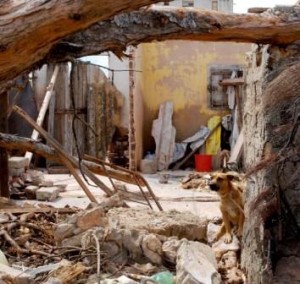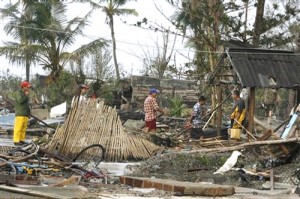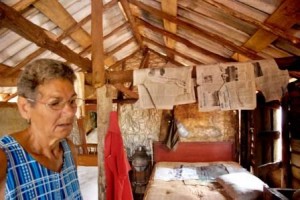Cuba Must Adapt to Storms
By Patricia Grogg

HAVANA TIMES, Nov 12 (IPS).- Three hurricanes have caused a total of 10 billion dollars in damages in Cuba in less than three months, according to the latest official estimates, while highlighting the vulnerability of Cuban housing to storms.
“As a result of climate change, hurricanes are going to become increasingly frequent and intense. We have no choice but to adapt,” President Raul Castro said this week on a tour of Camaguey and Las Tunas, two east-central provinces whose coastal areas were pounded by Hurricane Paloma on Saturday.
Although the hurricane quickly weakened after making landfall, the combined action of the wind, torrential rains and sea surges left hundreds of families in coastal towns like Santa Cruz del Sur in Camaguey and Guayabal in neighboring Las Tunas homeless.
In Guayabal, 110 homes were completely destroyed, while the rest of the 273 dwellings in the town suffered damages to varying degrees, when a one-meter surge drove 700 meters inland. The streets were littered with telephone poles.
In Santa Cruz del Sur, meanwhile, 9,889 homes were damaged, including 1,353 that were totally destroyed, when a four-meter storm surge flooded a mile inland.
“My life was saved, but I lost everything,” one woman told the local TV station on Sunday.

Televised images showed the destruction caused by Paloma in that town on the southern coast of Cuba just a few hours after the 76th anniversary of the worst catastrophe in the history of Cuba: a Nov. 9, 1932 cyclone that claimed 3,000 lives in the same area.
“There are still people alive who survived that storm on Nov. 9, 1932. Entire families were killed. It was terrible,” Digna García, a retired high school teacher from Camaguey, 534 km from Havana, told IPS.
This time around, everyone in the area was evacuated in a timely fashion.
“They are costly measures, but it is difficult to think about what would have happened if we had not evacuated,” said Castro, who told local residents that their homes would be rebuilt as soon as possible, in the same area, but farther from the sea. He also promised that the belongings lost by families would be replaced.
He said Cuba must get ready to “coexist” with hurricanes, and added that a total of 47 municipalities were affected by Hurricanes Gustav and Ike, which walloped the country between Aug. 30 and Sept. 9, and Paloma.
“We are spending what we have and what we do not have (on purchases of food and construction materials),” he said.
Granma newspaper reported Wednesday that Gustav and Ike caused 2.07 and 7.27 billion dollars in losses, respectively.
Castro, meanwhile, said that with the damages caused by Paloma, “we are almost reaching 10 billion dollars” in losses.
Although Cuba’s internationally acclaimed disaster prevention, run by the Civil Defense System, has kept the loss of human life to a minimum, but the material damages have been severe, aggravating, among other things, the housing shortage, already acknowledged by the government as one of the country’s most pressing problems.

Granma reported that the housing that was destroyed or seriously damaged by Paloma was added to the “half a million units damaged by Gustav and Ike.” In the coastal regions of central Cuba, most houses are made of wood with tile roofs.
Experts say the combined effects of the increasingly aggressive climate, poor quality of construction materials, lack of regular maintenance of infrastructure and location of homes in low-lying areas close to the sea make coastal towns especially vulnerable to the frequent hurricanes and tropical storms.
In the wake of Ike and Gustav, the National Housing Institute reported that only reinforced concrete roofs withstood the winds, and that the worst damages were sustained by homes with thatched roofs or roofing materials of wood or fiber-cement sheets, all of which are common in rural areas.
“We are going to try to lay the foundation for a construction materials industry, because until every house in this country has a solid roof, we will be replacing roofs over and over again,” said the president.
Earlier this year, the total housing shortage in Cuba was estimated at 600,000 units. A program launched in 2005 was originally aimed at building 100,000 new dwellings a year, but the figure had to be scaled back to a more realistic number, and was cut in half, said the authorities.





